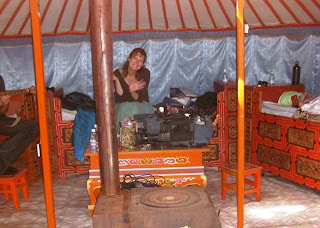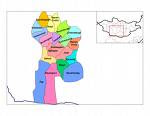As our fellow Peace Corps Volunteer Kevin put it with tongue in cheek, the best part of sharing the celebratory meal afterward, is that no one in the restaurant knew what big stars we were.
For the big summer festival of
Naadam,
Eagle TV, a Christian TV channel, wanted to do a show about foreigners performing Mongolian music. After seeing our swearing-in videos on
youtube, they called Peace Corps. We met to discuss, and this weekend six of us made the magic happen. It will air on cable and streaming on the internet at 8 p.m. (8 a.m. EST in the States) during the third day of Naadam, July 13, 2009.
We were supposed to meet at 8:30 in the morning at the Peace Corps office, but the camera crew didn’t show up until hours later. We weren’t all that surprised because they’d shown up six hours and four hours late for the previous two meetings, but we were nonetheless naively prepared for a reasonably on-time arrival. They did send a handler at about 9:15 to make sure we were all there.
When the camera crew finally arrived, they took a quick shot of us heading out of the office and we headed out of UB to
Tereelj National Park. The ride through the winding road included a few random stops along the way like when we parked near some folks selling camel rides to tourists, and when we checked in on an overturned SUV that had recently driven off the road scattering and trapping passengers and gear (everyone seemed miraculously OK).
 Our Trailer
Our TrailerWe arrived at the consummate countryside oasis complete with a stream, trees and large birds of prey, including a pair of large hawks. For our “trailer” they set us up in a nice ger where we were able to relax and nap for a few hours before our lunch of tsuivan (how Mongolian's do chow mien).

 Costumes
CostumesThe rest of the crew arrived with costumes soon after, which we got to play around with. These are the finest quality traditional outfits, made by perhaps the finest tailors in UB, according to our producer. No one took our measurements, but everyone's deel fit well with the exception of the boots, which were a few inches too small for the guys.

 Julia and Leslie pose in their fancy deels.
Julia and Leslie pose in their fancy deels.
 Nathan's feet are mostly up in the legs of the boots, high-heel style.
Nathan's feet are mostly up in the legs of the boots, high-heel style.


 We all got a bit of the "pose fever" in our awesome costumes. Jaime [left] pauses for a moment at least a dozen feet in front of the trained eagle.
We all got a bit of the "pose fever" in our awesome costumes. Jaime [left] pauses for a moment at least a dozen feet in front of the trained eagle.
Jaime LyOnce we were in costume, the real filming began. First was Jaime Ly performing her traditional Mongolian dance about nature and animals while the rest of us enthusiastically watched. Jaime, whose parents are Vietnamese, hails from Washington, D.C. She had some costuming problems because the outfit that was appropriate for that ethnic group was not the dance outfit, and there were no dancing shoes for her. No problem, though. Take after take using the cassette tape deck in the mini-van as her accompaniment, and despite having no formal dance training, she made do with what she had and put on quite a show.



Jaime performs her dance beautifully
in the afternoon sun as the crew rehearses how they'll film it.
Leslie and NathanNext, they set the two of us up with some creative direction. All in Mongolian, the producer pulled Nathan aside and described how the shot would work. He would sneak up from behind Leslie, pick a flower and hand it to her as a surprise before the music began. In two takes, with no accompaniment, we sang our love song. We haven’t seen the footage yet, but we felt the second take was about as well as we could do it. Fingers crossed!




You'd never know that the microphone is under that pile of leaves on that tree trunk.

It only took us two takes to get our performance on film. Hopefully they were the right two. We were a little nervous.

Julia CannonDespite delays, once the shooting began, there was no stopping – they moved right into shooting Julia’s “Ankhni Hair” (First Love). You might remember Julia from our
Bayankhongor concert from a few months ago. Julia is from Winston-Salem, NC, and has a theater degree. For her performance, she and the crew crossed the stream, and she was set up in a bright little clearing. It took several takes for them to get what they were looking for because they started with her walking, but because there was just a boom microphone (that captures all sounds in the immediate area), they were picking up the crunching of twigs and leaves beneath her feet. She sang quietly seated a few times, and that seemed to do the trick.
No pole for the boom mic? No problem as long as you have a ger and mailing tape nearby.



Julia and the crew had to cross the stream for this shot. I was no problem once the shoes came off.



Amber BookNext, for Amber Book, they went to a new location with fewer trees and more mountains because Amber has been volunteering in the far West in
Hovd that has a different landscape. This region is heavily comprised of ethnic Kazaks, so though Amber learned a little Mongolian two years ago during her Peace Corps’ Pre-service Training, she has primarily been speaking Kazak since she went to site. Amber sang, “Tulan Jer”, a Kazak song about missing ones homeland. Amber, who’s from Pittsburgh, PA, and has a vocal performance degree from Indiana University of Pennsylvania.


 The Eagle
The Eagle
In the Kazak region, eagle training and hunting using eagles is a big deal, culminating with the annual
Eagle Festival in October. On the way through Tereelj National Park, we saw a guy with a trained eagle sitting next to the road, so the camera crew stopped and hired it and the trainer for the day. This thing was huge, standing about two and a half feet high with a wing span of over a few yards. At one point, one of the hawks that lives in this area was swooping down trying to provoke the competing bird. Thankfully, it was blinded with a leather mask because I would not want to get on its bad side.



The handler moves the eagle. What an impressive wingspan.
Julia, Jaime and we take turns posing
with the blinded eagle from a safe distance.

 Kevin Johnstone
Kevin JohnstoneWe took a moment to enjoy a specially prepared
horhog, then the final sequence began with Kevin Johnstone from Cleveland, OH. He’s been playing guitar for about 16 years. He is mostly self taught with some intermittent formal education smattered in, and he
recorded an original album in his ger this past winter. He’s been in Selenge Province (the same where Leslie and I trained) in a small village for about two years, and just like Jaime, Julia and Amber, he’s an English teacher. He’s set to leave in August after he finishes helping
a monastery develop marketing materials.
Kevin entertained us and flawlessly performed a more modern selection, "Cetgeliin Jiguuree" (Wings of My Heart), on Leslie’s Martin guitar. We all stood by and cheered him on, dancing and acting a fool to finish the filming day.
 Kevin's performance was the final of the day.
Kevin's performance was the final of the day.

Deep in the trees, it began to get dark pretty early.


After some van problems, we finally made it back to UB after midnight, 15 hours after the day began. We Americans agreed that in the States, the amount of filming we did probably would have been done in just a five or six hours including travel, but we also all agreed that the day was a resounding success.
StudioThe next day, we made it back to the Peace Corps office by 10 a.m. to meet the camera crew that was also supposed to meet us there at that time. When they showed up after noon, our collective patience was a little frayed, but we sucked it up nonetheless for a ride out the airport. One shot of us coming out of the airport, and we headed for the studio.




In the studio, we each sat down with a reported who asked us various questions about our backgrounds. Five out of the six of us conducted the interview in Mongolian, but they asked Nathan to do his in English for the English speaking audience.
Finally, with our fates sealed in the hands of the editors, we all went out for hamburgers, salads and a cold drink to celebrate the making of our first music video in Mongolia.
Broadcasting – When, Where, HowTo check out our performance live on cable and internet July 13, 2009, tune in to:
Streaming video at 8 p.m. in Mongolia (8 a.m. EST)
http://www.eagle-tv.mn/mn/or
Eagle TV in UB on cable and terrestrial broadcast at 8 p.m.
 A gaggle of teams racing up the mountain to be the first team to the yellow rock.
A gaggle of teams racing up the mountain to be the first team to the yellow rock.

































































